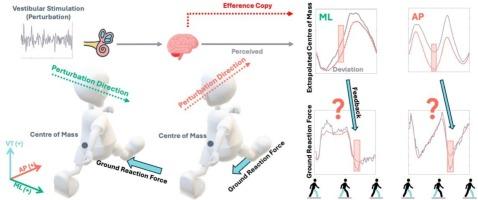Contribution of vestibular afference to estimation of centre of mass state for stabilization of walking differs between anteroposterior and mediolateral directions
IF 2.8
3区 医学
Q2 NEUROSCIENCES
引用次数: 0
Abstract
Walking without falling requires correcting the deviations of the centre of mass (CoM) trajectory relative to the base of support. This process is partially under feedback control. We investigated whether vestibular afference contributes to estimating CoM state to stabilize walking. We disturbed the vestibular afference by electrical vestibular stimulation (EVS), which typically leads to responses coherent with the stimulus and directed opposite to movement direction encoded by the induced vestibular signal. With the head facing forward, EVS induces mediolateral perturbations, which shift into the anteroposterior direction when the head is turned sideward in standing. Thirteen participants walked on a treadmill for 8 min at 78 steps/min and 2.8 km/h in four conditions, defined by the presence of EVS and head orientations (facing forward or leftward). A linear regression between the CoM state, described as the extrapolated CoM, and the delayed ground reaction force (GRF) was fitted, which was used to identify a ‘feedback model’. Negative correlations were found in all conditions, indicating that delayed compensatory actions are modulated to correct the deviation of CoM state. EVS significantly increased the magnitude of the GRF not predicted by the XCoM, i.e. the residual error of the feedback model. Contrary to our hypothesis, the increase in the anteroposterior direction was significantly smaller when walking with head facing leftward than when facing forward. Our findings indicate that vestibular afference contributes to estimating CoM state for walking stabilization in the mediolateral direction, but they do not support such a contribution for the anteroposterior direction.

前庭参考对稳定行走的重心状态估计的贡献在正前方和中外侧方向上是不同的
行走而不跌倒需要纠正质量中心(CoM)轨迹相对于支撑基础的偏差。这个过程部分地受反馈控制。我们研究了前庭传入是否有助于估计CoM状态以稳定行走。我们通过前庭电刺激(EVS)干扰前庭传入,这通常会导致与刺激一致的反应,并与诱导前庭信号编码的运动方向相反。当头部朝向前方时,EVS会引起中外侧扰动,当站立时头部侧转时,这种扰动会转移到前后方向。13名参与者在跑步机上以78步/分钟和2.8公里/小时的速度行走8分钟,在四种条件下,由EVS的存在和头部方向(面向前方或向左)定义。CoM状态(称为外推CoM)与延迟地面反作用力(GRF)之间的线性回归被拟合,用于识别“反馈模型”。在所有条件下均发现负相关,表明延迟补偿行为被调节以纠正CoM状态的偏差。EVS显著增加了XCoM无法预测的GRF的大小,即反馈模型的残差。与我们的假设相反,当头朝左行走时,前后方向的增加明显小于头朝前行走时。我们的研究结果表明,前庭传入有助于估计中外侧方向行走稳定的CoM状态,但不支持对正前方方向的贡献。
本文章由计算机程序翻译,如有差异,请以英文原文为准。
求助全文
约1分钟内获得全文
求助全文
来源期刊

Neuroscience
医学-神经科学
CiteScore
6.20
自引率
0.00%
发文量
394
审稿时长
52 days
期刊介绍:
Neuroscience publishes papers describing the results of original research on any aspect of the scientific study of the nervous system. Any paper, however short, will be considered for publication provided that it reports significant, new and carefully confirmed findings with full experimental details.
 求助内容:
求助内容: 应助结果提醒方式:
应助结果提醒方式:


